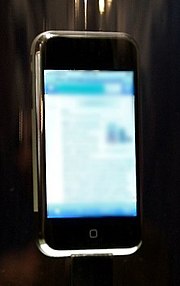The iPhone's functions include those of a camera phone and a multimedia player, in addition to text messaging and visual voicemail. It also offers Internet services including e-mail, web browsing, and local Wi-Fi connectivity. User input is accomplished via a multi-touch screen with virtual keyboard and buttons!!!!!
The iPhone allows conferencing, call holding, call merging, caller ID, and integration with other cellular network features and iPhone functions. For example, a playing song fades out when the user receives a call. Once the call is ended the music fades back in.
The iPhone includes a Visual Voicemail feature in conjunction with AT&T which allows users to view a list of current voicemail messages on-screen, without having to call into their voicemail. Unlike most other systems, messages can be listened to in a non-chronological order, by choosing messages from an on-screen list. AT&T modified their voicemail infrastructure to accommodate this new feature designed by Apple.
SMS messages are presented chronologically in a mailbox format similar to Mail, which places all text from recipients together with replies. Text messages are displayed in speech bubbles (similar to iChat) under each recipient's name.
 |  People waiting in New York City for the i-phone release People waiting in New York City for the i-phone release |
|---|---|
 |
 When the child moves to the tiger cage the short range receiver located near tiger cage reports the presence of a Bluetag device, within its short 10m proximity, and allows the positioning system to inform security about the new position of a child within the Zoo. Additionally, it also allows one to track a child's movements, for example, from the lion cage to the tiger cage. The data can be later used to draw a map of the movement inside the Zoo within a 10 meter accuracy range, and then inform Zoo staff about the length of stay at each location. In addition to the safety factor, this also provides statistics to management on which animals or parts of the Zoo's facilities are the most popular among children. Overall, this solution is an example of a beneficial use of the Bluetooth technology, which in this case helps to ensures the safety of the children visiting the Zoo. Yet, as one might anticipate, this beneficial idea of using Bluetooth in positioning and tracking can also have a dark side.
When the child moves to the tiger cage the short range receiver located near tiger cage reports the presence of a Bluetag device, within its short 10m proximity, and allows the positioning system to inform security about the new position of a child within the Zoo. Additionally, it also allows one to track a child's movements, for example, from the lion cage to the tiger cage. The data can be later used to draw a map of the movement inside the Zoo within a 10 meter accuracy range, and then inform Zoo staff about the length of stay at each location. In addition to the safety factor, this also provides statistics to management on which animals or parts of the Zoo's facilities are the most popular among children. Overall, this solution is an example of a beneficial use of the Bluetooth technology, which in this case helps to ensures the safety of the children visiting the Zoo. Yet, as one might anticipate, this beneficial idea of using Bluetooth in positioning and tracking can also have a dark side.
